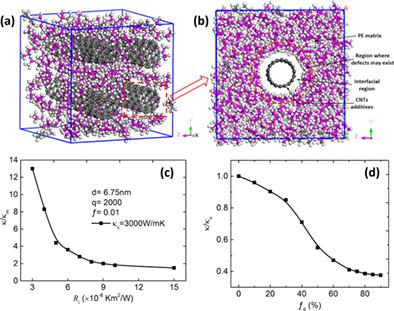当前位置:
X-MOL 学术
›
Polym. Compos.
›
论文详情
Our official English website, www.x-mol.net, welcomes your
feedback! (Note: you will need to create a separate account there.)
Thermal conductivity of aligned CNT‐polyethylene nanocomposites and correlation with the interfacial thermal resistance
Polymer Composites ( IF 4.8 ) Pub Date : 2020-06-22 , DOI: 10.1002/pc.25676 Lanyu Liu 1 , Zhaoxia Zhang 2 , Xiaofan Gou 1
Polymer Composites ( IF 4.8 ) Pub Date : 2020-06-22 , DOI: 10.1002/pc.25676 Lanyu Liu 1 , Zhaoxia Zhang 2 , Xiaofan Gou 1
Affiliation

|
Carbon nanotube (CNT) reinforced polymer composites have higher thermal conductivity than polymers themselves, so they have wide application prospects in many thermodynamic applications. It is of great significance to deeply understand the thermal conductivity of polymer nanocomposites and its creations, especially with the CNT‐polymer interface. In this article, for CNT‐polyethylene (PE) nanocomposites, the temperature distribution and thermal conductivity, and its correlation with the CNT volume fraction, the interfacial thermal resistance caused by interfacial defects in the CNT‐PE interface region, and mechanical strain were comprehensively studied through molecular dynamics simulation. The results show that the CNT volume fraction and mechanical stretches have remarkable effects on the thermal conductivity of the nanocomposite, and comparatively the influence of the interfacial defects is weak just in the range of the CNT volume fraction <0.3. The thermal conductivity rapidly increases when the volume fraction of CNTs changes from 0 to 0.20. Under tensile strain, the thermal conductivities κ∥ and κ⊥ (being parallel to and perpendicular to the stretching direction, also the direction of nanotubes) display quite different rules. The κ∥ increases linearly with the tensile strain, while the κ⊥ decreases linearly. After the CNT‐PE interfacial defect degree fd of assessing the defect extent was introduced, its dependence on the interfacial thermal resistance Ri was analytically given, and further the influence of the fd on the thermal conductivity was obtained through comparative studies of with/without interfacial defects. We found that the thermal conductivity has a sharply deduce when the fd is in the range of 30% to 60%.
中文翻译:

对齐的CNT-聚乙烯纳米复合材料的热导率及其与界面热阻的关系
碳纳米管(CNT)增强的聚合物复合材料具有比聚合物本身更高的导热性,因此在许多热力学应用中具有广阔的应用前景。深刻理解聚合物纳米复合材料的热导率及其产生,特别是对于CNT-聚合物界面,具有重要意义。本文对CNT-聚乙烯(PE)纳米复合材料的温度分布和热导率及其与CNT体积分数的关系,由CNT-PE界面区域中的界面缺陷引起的界面热阻以及机械应变进行了综合通过分子动力学模拟研究。结果表明,碳纳米管的体积分数和机械拉伸对纳米复合材料的热导率有显着影响,且仅在CNT体积分数<0.3的范围内,界面缺陷的影响较弱。当CNT的体积分数从0变为0.20时,导热系数迅速增加。在拉伸应变下,热导率κ ∥和κ ⊥(平行于和垂直于拉伸方向,纳米管的也方向)显示相当不同的规则。该κ ∥与拉伸应变线性地增加,而κ ⊥线性减小。在介绍了评估缺陷程度的CNT-PE界面缺陷度f d之后,分析地给出了其对界面热阻R i的依赖性,并进一步研究了f d的影响。通过对有无界面缺陷的比较研究获得了导热系数。我们发现,当f d在30%至60%的范围内时,热导率会急剧下降。
更新日期:2020-06-22
中文翻译:

对齐的CNT-聚乙烯纳米复合材料的热导率及其与界面热阻的关系
碳纳米管(CNT)增强的聚合物复合材料具有比聚合物本身更高的导热性,因此在许多热力学应用中具有广阔的应用前景。深刻理解聚合物纳米复合材料的热导率及其产生,特别是对于CNT-聚合物界面,具有重要意义。本文对CNT-聚乙烯(PE)纳米复合材料的温度分布和热导率及其与CNT体积分数的关系,由CNT-PE界面区域中的界面缺陷引起的界面热阻以及机械应变进行了综合通过分子动力学模拟研究。结果表明,碳纳米管的体积分数和机械拉伸对纳米复合材料的热导率有显着影响,且仅在CNT体积分数<0.3的范围内,界面缺陷的影响较弱。当CNT的体积分数从0变为0.20时,导热系数迅速增加。在拉伸应变下,热导率κ ∥和κ ⊥(平行于和垂直于拉伸方向,纳米管的也方向)显示相当不同的规则。该κ ∥与拉伸应变线性地增加,而κ ⊥线性减小。在介绍了评估缺陷程度的CNT-PE界面缺陷度f d之后,分析地给出了其对界面热阻R i的依赖性,并进一步研究了f d的影响。通过对有无界面缺陷的比较研究获得了导热系数。我们发现,当f d在30%至60%的范围内时,热导率会急剧下降。









































 京公网安备 11010802027423号
京公网安备 11010802027423号